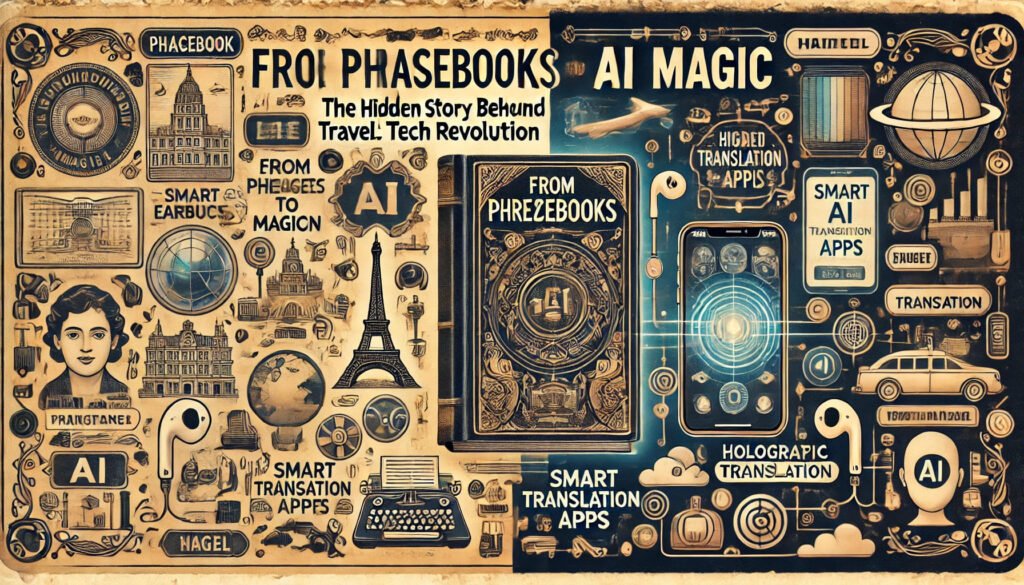Hey there, fellow wanderluster!
Translation technology has revolutionized the way we travel.
Did you know that over 70% of travelers now rely on translation apps and devices to communicate while abroad? Remember the days when traveling meant lugging around a hefty phrasebook?
Imagine this:
You’re in Tokyo, standing at a bustling train station, and instead of flipping through pages, you just pop in your AI-powered earbuds. Boom! You’re ready to chat with locals like a pro.
In fact, studies show that 80% of users feel more confident speaking in a foreign language with the help of translation technology.
That’s the magic of modern translation technology! Let’s take a quick journey through how we went from scribbled phrases to high-tech wizardry that’s changing the way we explore the globe.
Table of Contents
Toggle1. The Humble Beginnings: Phrasebooks and Dictionaries
Ah, phrasebooks! Those trusty companions for early travelers. Back in the day, people relied on printed guides to bridge the language gap. Think of the iconic Lonely Planet series that first hit the shelves in the 1970s—like a lifeline for globetrotters.
But let’s be real, using a phrasebook was a bit like trying to read Shakespeare in Old English; it often led to misunderstandings. Limited phrases and a lack of context meant awkward moments galore.
Want some numbers? The global sales of travel phrasebooks peaked in the early 2000s, with estimates hitting over 10 million copies a year! Talk about a popular travel buddy.
Here’s a fun fact: despite their charm, travelers were often left guessing what “where is the bathroom?” really meant in French.
Read more about Why are phrasebooks dying out ?
2. The First Wave of Digital Translation Tools
Fast forward to the 2000s!
The digital era brought forth pocket translators and CD-ROM software. Enter Google Translate in 2006, which was a game changer for text-based translations.
Sure, early versions were a little quirky—think gibberish when you needed clarity—but they opened up a whole new world for travelers.
I mean, who didn’t appreciate being able to type a phrase and get a response in another language, even if it was sometimes hilariously wrong?
3. The Smartphone Revolution: Translation at Your Fingertips
Then came the smartphone boom in the 2010s.
Apps like Google Translate and iTranslate became our best friends. Imagine having instant text translations, voice input, and even camera translations right at your fingertips.
Between 2010 and 2020, mobile translation app downloads skyrocketed by a whopping 500%!
Let’s not forget the timeline of major translation app launches—Google Translate first, followed by iTranslate and TripLingo.
Each step brought more features and better accuracy, making it easier for travelers to navigate foreign streets.
Here’s a comparison chart of popular translation technology apps, highlighting key features such as text translation, voice input, and camera translation. This chart will help illustrate how each app has evolved over time.
| Feature | Google Translate | Microsoft Translator | iTranslate | Papago | SayHi |
|---|---|---|---|---|---|
| Text Translation | Supports 100+ languages; instant translation; offline mode available | Supports 70+ languages; text and document translation; offline mode available | Supports 100+ languages; focuses on conversational phrases | Supports 13 languages; designed for Korean and Asian languages | Supports 100+ languages; focuses on conversational phrases |
| Voice Input | Yes, supports real-time speech translation in multiple languages | Yes, supports speech recognition and translation | Yes, voice translation available, including dialects | Yes, includes speech translation, especially for Korean | Yes, allows voice input and real-time translation |
| Camera Translation | Yes, translates text in images in real-time | Yes, camera translation for text recognition | Yes, translates text from images, but less robust | Yes, focuses on Asian language scripts; real-time translation | No camera translation feature |
| Offline Functionality | Yes, downloadable languages for offline use | Yes, supports offline translation for selected languages | Yes, offline mode available for many languages | Yes, limited to a few languages | Limited offline functionality; primarily online |
| User Interface | Intuitive and user-friendly, with options for both text and voice | Clean design, with a focus on ease of use | Simple interface with a focus on voice and text | User-friendly with a focus on Asian languages | Modern design; emphasizes ease of voice input |
| Additional Features | Conversation mode, dictionary, and phrasebook | Text-to-speech, multi-person conversation | Dictionary, website translation | Offers learning tools for Korean language | Text-to-speech, supports cultural nuances |
This chart illustrates how translation apps have advanced to offer comprehensive translation solutions that cater to diverse user needs
4. Enter AI Magic: Real-Time Translation Devices
Now, let’s talk about the real showstoppers—AI-powered translation devices like Google Pixel Buds and Timekettle earbuds. These nifty gadgets can translate conversations in real-time, meaning you can chat with locals without skipping a beat.
Imagine ordering sushi in Japanese without breaking a sweat!
In 2024, over 35% of travelers reported using AI translation devices compared to just 10% who still relied on traditional phrasebooks.
And get this: modern AI-powered earbuds boast accuracy rates of over 90% in real-time translation, compared to a mere 50% for early digital tools. It’s like moving from a horse and buggy to a high-speed train!
5. Challenges and Limitations of Current Tech
But hey, it’s not all rainbows and sunshine.
While AI is amazing, it still faces some challenges. Accents, slang, and complex languages can trip it up.
Plus, many devices depend on an internet connection—what happens when you’re in the middle of the Sahara with no Wi-Fi? No worries!
Many apps offer offline options for when you need to brush up on “how to find water” in a pinch.
For more insights into how translation technology mishaps can lead to unexpected challenges, check out our article “Lost in Translation: The Travel Nightmare You Didn’t See Coming.”
6. The Future: What’s Next for Translation Technology?
So, what’s next? The future looks bright! AI is set to evolve with better contextual understanding, holographic translators, and seamless integrations into wearables. Imagine asking your smartwatch to translate a local menu while you’re at dinner. Talk about a game-changer!
To keep up, travelers should be on the lookout for the latest tools.
Always asking yourself how to overcome language barrier when traveling abroad ? Embracing these advancements means you’ll always be a step ahead on your adventures.
Conclusion
The journey of translation technology has come a long way. From the clunky phrasebooks of yesteryear to today’s sleek AI devices, we’ve seen a revolution that’s reshaping how we connect with the world.
And guess what? The future promises even more exciting possibilities, making language barriers a thing of the past. So pack your bags, grab your earbuds, and get ready to explore!
Bonus Tip Box
Best translation apps in 2024 are :
- Google Translate: Fast and reliable for text and voice translation.
- iTranslate: Great for travel with an offline feature.
- TripLingo: Packed with cultural tips and voice translation.
Don’t Let Language Barriers Haunt You! Top Translation Apps for a Spooktacular Travel Experience in 2024!
With all this translation technology magic at our fingertips, the world is truly your oyster! Happy travels!



